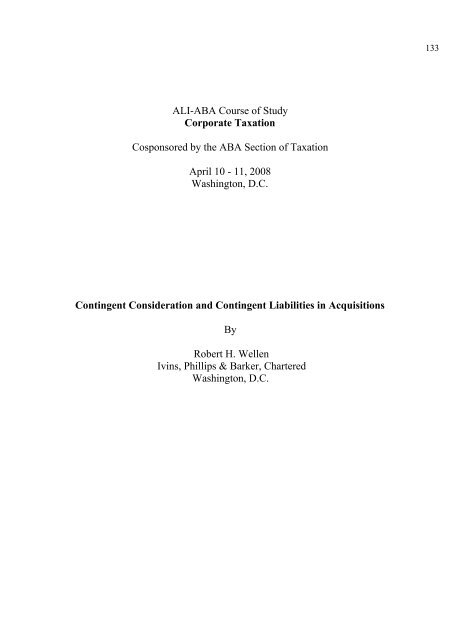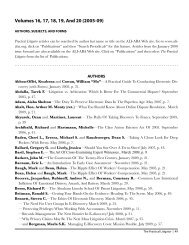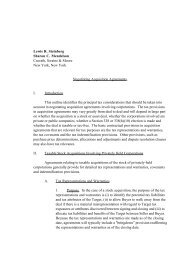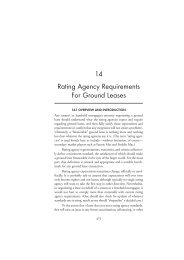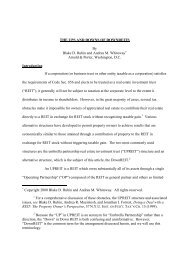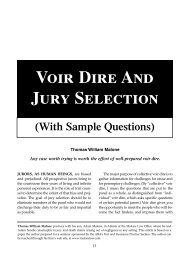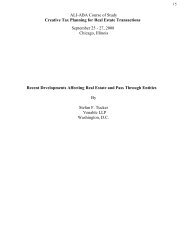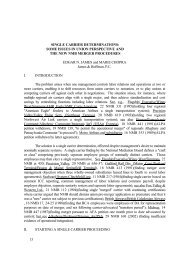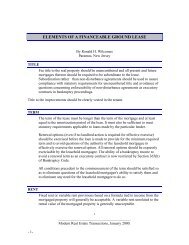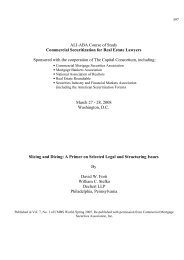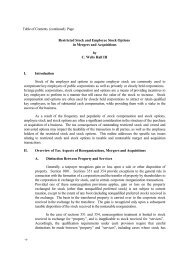contingent consideration and contingent liabilities in acquisitions
contingent consideration and contingent liabilities in acquisitions
contingent consideration and contingent liabilities in acquisitions
Create successful ePaper yourself
Turn your PDF publications into a flip-book with our unique Google optimized e-Paper software.
133<br />
ALI-ABA Course of Study<br />
Corporate Taxation<br />
Cosponsored by the ABA Section of Taxation<br />
April 10 - 11, 2008<br />
Wash<strong>in</strong>gton, D.C.<br />
Cont<strong>in</strong>gent Consideration <strong>and</strong> Cont<strong>in</strong>gent Liabilities <strong>in</strong> Acquisitions<br />
By<br />
Robert H. Wellen<br />
Iv<strong>in</strong>s, Phillips & Barker, Chartered<br />
Wash<strong>in</strong>gton, D.C.
134<br />
CONTINGENT CONSIDERATION AND<br />
CONTINGENT LIABILITIES IN ACQUISITIONS<br />
–––––––––<br />
OUTLINE<br />
–––––––––<br />
MARCH 2008<br />
ROBERT H. WELLEN<br />
IVINS, PHILLIPS & BARKER<br />
WASHINGTON, D.C.<br />
TABLE OF CONTENTS<br />
INTRODUCTION ...........................................................................................................................1<br />
NOMENCLATURE ........................................................................................................................3<br />
TAXABLE ASSET AND STOCK ACQUISITIONS.....................................................................4<br />
I. Cont<strong>in</strong>gent Purchase Price <strong>in</strong> Acquisitions of Assets <strong>and</strong> Acquisitions of Stock<br />
Without Section 338(h)(10) Elections .......................................................................................4<br />
A. Treatment of Seller – Choice Between Installment Method <strong>and</strong> Election Out....................4<br />
B. Treatment of Seller – Election Out of Installment Method .................................................4<br />
1. Amount Realized at Clos<strong>in</strong>g ..........................................................................................4<br />
2. Cont<strong>in</strong>gent Payments After Clos<strong>in</strong>g – Closed Transaction ...........................................7<br />
3. Amounts Received After Clos<strong>in</strong>g – Open Transactions..............................................18<br />
4. Allocation of Amounts Realized Among Assets Sold.................................................18<br />
5. Possible Treatment of Cont<strong>in</strong>gent Purchase Price Obligation as Target Stock...........19<br />
C. Treatment of Seller – Installment Method.........................................................................19<br />
1. Application...................................................................................................................19<br />
2. Election ........................................................................................................................19<br />
3. Deferral Charge............................................................................................................19<br />
4. Method of Calculat<strong>in</strong>g Ga<strong>in</strong> Recognized.....................................................................20<br />
5. Allocat<strong>in</strong>g Installment Obligation to Certa<strong>in</strong> Assets ...................................................23<br />
6. Net Benefits <strong>and</strong> Detriments of Installment Sale Method to Seller.............................24<br />
D. Treatment of Acquiror .......................................................................................................24<br />
1. Allocation of Cont<strong>in</strong>gent Purchase Price Among Assets Purchased...........................24<br />
2. Specific Allocations – Intangible Assets .....................................................................25<br />
3. Tim<strong>in</strong>g of Effects on Basis <strong>and</strong> Interest Deductions ...................................................25<br />
4. Contracts for Use of Intangibles ..................................................................................25<br />
5. Interest..........................................................................................................................25<br />
E. Report<strong>in</strong>g Requirements ....................................................................................................26<br />
1. Section 1060 Acquisitions ...........................................................................................26<br />
2. Installment Method – Elect<strong>in</strong>g Out..............................................................................26<br />
3. Installment Method ......................................................................................................26
135<br />
II. Cont<strong>in</strong>gent Purchase Price <strong>and</strong> Cont<strong>in</strong>gent Liabilities <strong>in</strong> Stock Acquisitions with<br />
Section 338(h)(10) Elections – New 338 Regulations.............................................................26<br />
A. Introduction........................................................................................................................26<br />
B. Treatment of Old T ............................................................................................................27<br />
1. Installment Method ......................................................................................................27<br />
2. Election Out of Installment Method ............................................................................29<br />
3. Allocation of Amounts Realized Among Assets Deemed Sold...................................32<br />
4. Character of Amounts Realized...................................................................................32<br />
C. Treatment of New T...........................................................................................................33<br />
1. Allocation of Cont<strong>in</strong>gent Purchase Price <strong>and</strong> Cont<strong>in</strong>gent Liabilities Among Assets<br />
Deemed Purchased.......................................................................................................33<br />
2. Tim<strong>in</strong>g of Effects on Basis ..........................................................................................33<br />
3. Elim<strong>in</strong>ation of Phantom Income ..................................................................................35<br />
4. “Break<strong>in</strong>g the L<strong>in</strong>k” Between ADSP <strong>and</strong> AGUB........................................................35<br />
D. Report<strong>in</strong>g <strong>and</strong> Adm<strong>in</strong>istrative Requirements.....................................................................36<br />
1. Forms 8023 <strong>and</strong> 8883...................................................................................................36<br />
2. Other Adm<strong>in</strong>istrative Requirements ............................................................................37<br />
II*. Cont<strong>in</strong>gent Purchase Price <strong>in</strong> Stock Acquisitions with Section 338(h)(10)<br />
Elections – Old 338 Regulations..............................................................................................37<br />
A. Treatment of Old T ............................................................................................................37<br />
1. Installment Method Not Available...............................................................................37<br />
2. Amount Realized at Clos<strong>in</strong>g ........................................................................................38<br />
3. Amount Realized Upon Receipt ..................................................................................38<br />
4. Allocation of Amounts Realized Among Assets Deemed Sold...................................38<br />
5. Post-Clos<strong>in</strong>g Adjustments............................................................................................38<br />
6. Recovery of Asset Basis ..............................................................................................39<br />
7. Character of Amounts Realized – Actual <strong>and</strong> Imputed Interest ..................................39<br />
B. Treatment of New T...........................................................................................................39<br />
1. Allocation of Cont<strong>in</strong>gent Purchase Price Among Assets Purchased...........................39<br />
2. Tim<strong>in</strong>g of Adjustments to New T’s Asset Basis..........................................................39<br />
III. Escrows <strong>and</strong> Other Returns of Purchase Price.........................................................................39<br />
A. Whose Property Is the Escrow .........................................................................................40<br />
1. Inclusion of Escrowed Funds <strong>in</strong> Seller’s Amount Realized at Clos<strong>in</strong>g.......................40<br />
2. Income on Escrowed Funds.........................................................................................40<br />
B. If Escrow Is Acquiror’s Property.......................................................................................41<br />
1. Escrow as Acquiror’s Property – Treatment at Clos<strong>in</strong>g to Seller................................41<br />
2. Escrow as Acquiror’s Property – Treatment at Clos<strong>in</strong>g to Acquiror...........................41<br />
3. Escrow as Acquiror’s Property – Income Earned on Escrowed Funds – Prop. Reg.<br />
§ 1.468B-8....................................................................................................................41<br />
4. Escrow as Acquiror’s Property – Treatment on Payment to Seller .............................42<br />
5. Escrow as Acquiror’s Property – Treatment on Return of Escrowed Funds to<br />
Acquiror .......................................................................................................................42<br />
6. Escrow as Acquiror’s Property – Treatment on Use of Escrowed Funds to Pay<br />
Seller Liabilities...........................................................................................................42<br />
ii
136<br />
C. If Escrow Is Seller’s Property............................................................................................43<br />
1. Escrow as Seller’s Property – Treatment at Clos<strong>in</strong>g to Seller.....................................43<br />
2. Escrow as Seller’s Property – Treatment of Escrow at Clos<strong>in</strong>g to Acquiror...............43<br />
3. Escrow as Seller’s Property – Income Earned on Escrowed Funds ............................43<br />
4. Escrow as Seller’s Property – Treatment on Payment to Seller ..................................44<br />
5. Escrow as Seller’s Property – Treatment on Return to Acquiror ................................44<br />
6. Escrow as Seller’s Property – Treatment on Use of Escrowed Funds to Pay Seller<br />
Liabilities .....................................................................................................................45<br />
D. If Escrowed Property Is Stock of Acquiror or Acquiror’s Parent <strong>in</strong> a Taxable<br />
Acquisition.........................................................................................................................45<br />
1. Escrowed Stock – Taxable Ga<strong>in</strong> to Acquiror ..............................................................45<br />
2. Escrowed Stock – Tax on Dividends...........................................................................46<br />
IV. Cont<strong>in</strong>gent Liabilities <strong>in</strong> Taxable Asset Acquisitions .............................................................46<br />
A. Introduction........................................................................................................................46<br />
B. Whose Liability Cont<strong>in</strong>gent Liability or Defect <strong>in</strong> Assets What Is at Stake................46<br />
1. Target’s or Acquiror’s Liability – Consequences........................................................46<br />
2. Alternative Analysis.....................................................................................................47<br />
3. Authorities....................................................................................................................47<br />
4. Authorities on Employee <strong>and</strong> Retiree Compensation <strong>and</strong> Benefits.............................49<br />
C. Treatment of Expenditures That Are Expenses of Acquiror .............................................51<br />
1. Treatment at Clos<strong>in</strong>g <strong>and</strong> upon Payment by Acquiror.................................................52<br />
2. Treatment of Indemnity Payment by Seller or Target to Acquiror..............................52<br />
D. Treatment if Target’s Liability Assumed...........................................................................53<br />
1. Non-Deductible Items..................................................................................................53<br />
2. Deductible Items ..........................................................................................................54<br />
3. Delayed Deductible Items – Section 404(a)(5)............................................................58<br />
4. Capital Items of Target ................................................................................................58<br />
5. Indemnity by Target to Acquiror – Reta<strong>in</strong>ed Cont<strong>in</strong>gent Liabilities...........................58<br />
E. Treatment if Target’s Liabilities Assumed – James M. Pierce Corp. Analysis ................59<br />
1. Prior Use of Pierce Analysis........................................................................................59<br />
2. Limits on Use of the Pierce Analysis ..........................................................................59<br />
3. Consequences of Pierce Analysis................................................................................59<br />
F. Treatment if Target’s Liabilities Assumed – Alternative Analyses...................................61<br />
1. Acquiror Steps <strong>in</strong>to Target’s Shoes .............................................................................61<br />
2. Surprise Expenses ........................................................................................................61<br />
3. Discounted Deduction..................................................................................................62<br />
4. Possible IRS Guidance.................................................................................................62<br />
V. Cont<strong>in</strong>gent Liabilities <strong>in</strong> Taxable Stock Acquisitions Without Section 338(h)(10)<br />
Elections...................................................................................................................................62<br />
A. Cont<strong>in</strong>gent Liabilities <strong>in</strong> General.......................................................................................62<br />
B. Cont<strong>in</strong>gent Liabilities as Built-<strong>in</strong> Loss ..............................................................................62<br />
1. Section 382(h)..............................................................................................................62<br />
2. Consolidated Return Matters .......................................................................................63<br />
iii
137<br />
C. Indemnity by Seller for Target’s Cont<strong>in</strong>gent Liabilities....................................................64<br />
1. General.........................................................................................................................64<br />
2. Treatment to Seller.......................................................................................................64<br />
3. Treatment to Acquiror <strong>and</strong> Target ...............................................................................65<br />
D. Other Indemnities or Compensation Payments Between the Parties.................................66<br />
1. Payments as Part of the Orig<strong>in</strong>al Transaction..............................................................66<br />
2. Payments as Part of a New Transaction.......................................................................66<br />
TAX-FREE ACQUISITIONS .......................................................................................................66<br />
VI. Cont<strong>in</strong>gent <strong>and</strong> Escrowed Stock <strong>in</strong> General ............................................................................66<br />
A. Background <strong>and</strong> General Treatment ..................................................................................66<br />
B. Advance Rul<strong>in</strong>g Guidel<strong>in</strong>es ...............................................................................................67<br />
C. Commentary.......................................................................................................................67<br />
D. Cont<strong>in</strong>gent <strong>and</strong> Escrowed Stock <strong>and</strong> the Cont<strong>in</strong>uity-of-Interest “Fixed”<br />
Consideration Rule.............................................................................................................68<br />
1. Background..................................................................................................................68<br />
2. Proposed Regulations...................................................................................................68<br />
3. Temporary Regulations................................................................................................68<br />
VII. Escrowed Stock........................................................................................................................68<br />
A. Escrowed Stock as “Stock”................................................................................................68<br />
B. Treatment at Clos<strong>in</strong>g..........................................................................................................69<br />
1. General.........................................................................................................................69<br />
2. Stock Basis...................................................................................................................69<br />
3. No Imputed Interest .....................................................................................................69<br />
4. Effect on Cont<strong>in</strong>uity of Interest ...................................................................................69<br />
C. Effect of Return of Escrowed Stock to Acquiror...............................................................69<br />
1. Possible Analyses.........................................................................................................69<br />
2. Returned Stock Valued at Clos<strong>in</strong>g...............................................................................69<br />
3. Changes <strong>in</strong> Stock Value Taken <strong>in</strong>to Account ..............................................................69<br />
4. Effect of Return of Escrowed Stock on Cont<strong>in</strong>uity of Interest....................................70<br />
VIII. Cont<strong>in</strong>gent Stock......................................................................................................................70<br />
A. Cont<strong>in</strong>gent Stock as “Stock” – Cont<strong>in</strong>uity of Interest .......................................................70<br />
B. Treatment at Clos<strong>in</strong>g..........................................................................................................70<br />
C. Second Acquisition ............................................................................................................70<br />
D. Treatment of Receipt by Former Target Shareholders – Imputed Interest ........................70<br />
1. Imputed Interest ...........................................................................................................70<br />
2. Interest Income to Target Shareholders as Received...................................................71<br />
3. Deduction to Acquiror .................................................................................................71<br />
4. Advantage of Escrowed Stock.....................................................................................72<br />
E. Treatment of Receipt of Cont<strong>in</strong>gent Stock by Former Target Shareholders –<br />
Effect on Basis of Acquiror Stock .....................................................................................72<br />
F. Effect of Non-Receipt by Former Target Shareholders.....................................................72<br />
IX. Options to Acquire Stock.........................................................................................................72<br />
A. Treatment of Options as Zero-Pr<strong>in</strong>cipal Securities............................................................72<br />
B. Treatment of Options as Boot <strong>in</strong> Certa<strong>in</strong> Exchanges.........................................................72<br />
C. Effect on Cont<strong>in</strong>uity of Interest .........................................................................................73<br />
iv
138<br />
X. Target’s Cont<strong>in</strong>gent Liabilities ................................................................................................73<br />
A. “Assumption” of Liabilities ...............................................................................................73<br />
1. Cross-Collateralized Debt -- Section 357(d)................................................................73<br />
2. BOSS Transactions -- Reg. § 1.301-1(g).....................................................................74<br />
3. Cont<strong>in</strong>gent Liability Shelters -- Notice 2001-17Section 358(h) <strong>and</strong> Section 362(e)...74<br />
4. Partnership Liabilities ..................................................................................................75<br />
B. Possible Effect of Assumption of Target’s Cont<strong>in</strong>gent Liabilities on Tax-Free<br />
Reorganization Status ........................................................................................................79<br />
1. Proposed Regulations on “Transactions Involv<strong>in</strong>g the Transfer of No Net Value”....79<br />
2. Identity of the “Acquir<strong>in</strong>g Corporation”......................................................................80<br />
3. “Cause-to-Direct” Acquisitions ...................................................................................80<br />
C. Deductions to Acquiror <strong>and</strong> Related Matters.....................................................................80<br />
1. Acquisitive Reorganizations – “Step-<strong>in</strong>-the-Shoes” Treatment ..................................80<br />
2. Acquisitive Reorganizations – Indemnities for Cont<strong>in</strong>gent Liabilities Paid by<br />
Acquiror .......................................................................................................................80<br />
3. Section 351 Exchanges – General................................................................................81<br />
4. Section 351 Exchanges – Scope <strong>and</strong> Mean<strong>in</strong>g of “Step-<strong>in</strong>-the-Shoes” Treatment .....82<br />
5. Note on Cont<strong>in</strong>gent Liabilities <strong>in</strong> Divisive Type-D Reorganizations..........................84<br />
v


